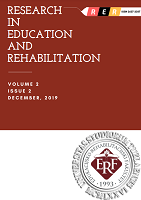ATTITUDES AND SOCIAL DISTANCE TOWARDS PERSONS WITH PHYSICAL DISABILITIES
ATTITUDES AND SOCIAL DISTANCE TOWARDS PERSONS WITH PHYSICAL DISABILITIES
Author(s): Vesna Bratovčić, Amela Teskeredžić, Alma Dizdarević, Hurma Begić JahićSubject(s): Sociology, Social psychology and group interaction, Behaviorism, Health and medicine and law
Published by: Edukacijsko-rehabilitacijski fakultet Univerziteta u Tuzli
Keywords: attitudes; the level of social distance; people with physical disabilities;
Summary/Abstract: The aim of this study was to examine the attitudes of the wider public towards persons with physical disability and determine the situation and the level of social distance towards this population of people with physical disabilities. The aim of the research was to determine the difference in the attitudes and the state of social distance in relation to age of persons covered by this study. The sample (N = 339) consisted of people of different ages, gender, qualifications and occupations chosen randomly from the territory of Bosnia and Herzegovina. The only criterion for the selection of the sample implies that these are people who have no personal or professional contact with persons with disabilities. The scale of social distance (Ouellette-Kuntz, Burge, Brown, Arsenault, 2010) for the purpose of this study was adapted in the sense that the required statements and opinions of respondents to people with physical disabilities, rather than to people with intellectual disabilities. Research data were processed by methods of non-parametric statistics. Frequencies and percentages were calculated. To investigate the influence of age on the respondents' attitudes towards persons with physical disabilities, cross - tabulation analysis was used, and for testing the significance of differences between the studied variables chi-square tests were used. The research results indicate that the majority of respondents showed a positive attitude and a low level of social distance towards persons with physical disabilities, although there is a smaller percentage of respondents who expressed negative attitudes and high levels of social distance. From the results of cross-tabulation analysis and chi-square test, it can be seen that there was no statistically significant difference in attitudes towards people with physical disabilities in relation to age of the respondents. With the increasing intimacy in the sentence or statement of the scale, the level of social distance among the respondents was increased too.
Journal: Research in Education and Rehabilitation
- Issue Year: 2/2019
- Issue No: 2
- Page Range: 35-45
- Page Count: 11
- Language: English

